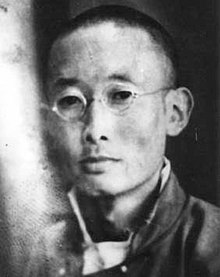Gendün Chöphel


Gendun ChompelorGendün Chöphel(Tibetan:དགེ་འདུན་ཆོས་འཕེལ།,Wylie:dge 'dun chos 'phel)[1](1903–1951) was aTibetanscholar, thinker, writer, poet, linguist, and artist. He was born in 1903 in Shompongshe,Rebkong,Amdo.He was a creative and controversial figure and is considered by many to have been one of the most important Tibetan intellectuals of the twentieth century.
Chöphel was a friend of the Indian scholar andindependenceactivistRahul Sankrityayan.His life was the inspiration for Luc Schaedler's filmThe Angry Monk: Reflections on Tibet.[2]He is best known for his collection of essays calledThe Madman's Middle Way: Reflections on Reality of the Tibetan Monk Gendun Chophel.[3]andGrains of Gold: Tales of a Cosmopolitan Pilgrimage,written during his time in India and Sri Lanka in between 1934 and 1946. These essays were critical of modernHinduism,Christianity,andBritish imperialism.While condemning places and events like theBlack Hole of Calcuttaand theGoa Inquisition,he praised certain British colonial practices of legislations.[4]
Hiseroticclassic,Treatise on Passion[5](Tibetan:འདོད་པའི་བསྟན་བཅོས།,Wylie:‘dod pa’i bstan bcos), was completed in 1939, though it was first published posthumously in 1967.[6]Written in Tibetan verse, this poetic and practical work was inspired both by his reading and partial translation of theKama Sutra(introduced to him by Sankrityayan) and by his own recent, and prolific,[5]sexual awakening.[6]The work aims to provide extensive[7]guidance on heterosexual lovemaking and sexual happiness for both women and men in an overtly democratic spirit.[6]By now an ex-monk, Chöphel was happy to compare favourably his detailed sexual guidance (written from a lay perspective) to that contained in an earlier – and much less explicit – work bearing a similar title composed byMipham the Great.[5]
See also[edit]
References[edit]
- ^Lopez Jr., Donald S.(2011)."Dge 'dun Chos 'phel and Tibetan religion in the 21st century"(pdf)(in English and Chinese). National Taiwan University.Archived(PDF)from the original on 12 August 2022.
- ^The Angry Monk: Reflections on Tibet
- ^Lopez Jr., Donald S. (2006).The Madman's Middle Way: Reflections on Reality of the Tibetan Monk Gendun Choephel.Chicago: The University of Chicago Press.ISBN0-226-49316-4.
- ^Schaeffer, Kurtis R; Kapstein, Matthew T; Tuttle, Gray, eds. (2013). "Tibetans Addressing Modern Political Issues".Sources of Tibetan Tradition.Columbia University Press. p. 753.
- ^abcJacoby, Sarah H. (2017)."The science of sensual pleasure according to a Buddhist monk: Ju Mipam's contribution to kāmaśāstra literature in Tibet"(PDF).Bulletin of the School of Oriental and African Studies.80(2): 319–337.doi:10.1017/S0041977X17000490.Archived(PDF)from the original on 1 June 2022.
- ^abcButler, John (22 April 2018).""The Passion Book: A Tibetan Guide to Love and Sex" by Gendun Chopel ".Asian Review of Books.Archivedfrom the original on 26 April 2018.
- ^Rossi, Donatella (2007). "L'iconoclast Gendün Chöphel (1905-1951) e il suo 'Kamasūtra'".Rivista degli studi orientali(in Italian).80(1/4): 141–147.ISSN0392-4866.JSTOR41913382.
Sources[edit]
Translations[edit]
- Chöphel, Gendün (2006),Clarifying the core of Madhyamaka: Ornament of the thought of Nagarjuna.(2nd ed.), Arcidosso, GR, Italy: Shang Shung Publications
- Chöphel, Gendun;Hopkins, Jeffrey(1993),Tibetan Arts of Love,Snow Lion Publications,ISBN0-937938-97-1
- Chöphel, Gedün (2006).Die tibetische Liebeskunst.Nietsch.ISBN3-934647-97-9.
- Chöphel, Gedun (1985).Dhammapada, Translation of the Dharma Verses with the Tibetan Text.Dharma Publishing.ISBN0-913546-98-4.
- Chöphel, Gedun (2009).In the Forest of Faded Wisdom: 104 Poems by Gendun Choephel, a Bilingual Edition, edited and translated by Donald S. Lopez Jr.University of Chicago Press.ISBN978-0-226-10452-2.
Other sources[edit]
- Bogin, Benjamin; Decleer, Hubert (1997), "Who was 'this evil friend' ('the dog', the 'fool', 'the tyrant') in Gedun Choephel's Sad Song?",The Tibet Journal,22(3): 67–78
- Dhondup, K.: "Gedun Choephel: the Man Behind the Legend".Tibetan Review,vol. 13, no. 10, October 1978, p. 10–18.
- Huber, Toni (2000).Guide to India, a Tibetan Account By: Gendun Choephel.Dharamsala, India: Library of Tibetan Works & Archives. pp. 162pp.ISBN81-86470-25-5.
- Jinpa, Thupten(2003), "Science as an Allay or a Rival Philosophy? Tibetan Buddhist Thinkers' Engagement with Modern Science", in Wallace, B. Alan (ed.),Buddhism & Science: Breaking New Ground,Published by Columbia University Press, pp. 71–85,ISBN0-231-12335-3
- Lopez, Donald S. (Jr.) (2007).The Madman's Middle Way: Reflections on Reality of the Tibetan Monk Gendun Choephel.University Of Chicago Press.ISBN0-226-49317-2.
- Mengele, Irmgard (1999).Gedun Choephel: A Biography of the 20th Century Tibetan Scholar.Dharamsala, India: Library of Tibetan Works & Archives.ISBN81-86470-23-9.
- Stoddard, Heather (1985).Le mendiant de l'Amdo (Recherches sur la Haute Asie).Paris: Societe d'ethnographie.ISBN2-901161-28-6.
- Roerich, George N.and Gedun Choephel (Translator) (1988).TheBlue AnnalsbyGö Lotsawa.Motilal Banarsidass, Delhi, 1976, Reprint in 1979. [reprint of Calcutta, Royal Asiatic Society of Bengal, 1949, in two volumes].
External links[edit]
- Peer reviewed biography of Gendun Chopel by Dr. Heather Stoddard on The Treasury of Lives
- Gendun Choephel
- The Story of a Monk Wanderer: part 1[1]Archived2015-04-02 at theWayback Machine,part 2[2]Archived2015-04-02 at theWayback Machine
- Gendun ChoephelArchived2015-12-02 at theWayback Machine– Angry Monk website
